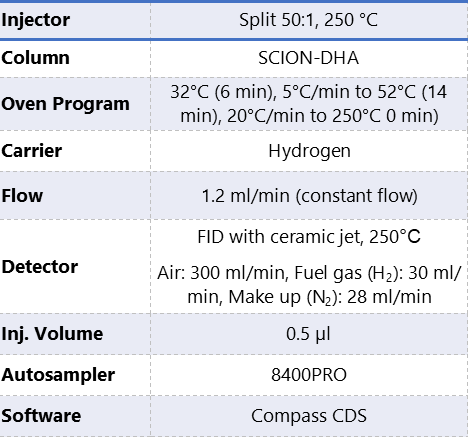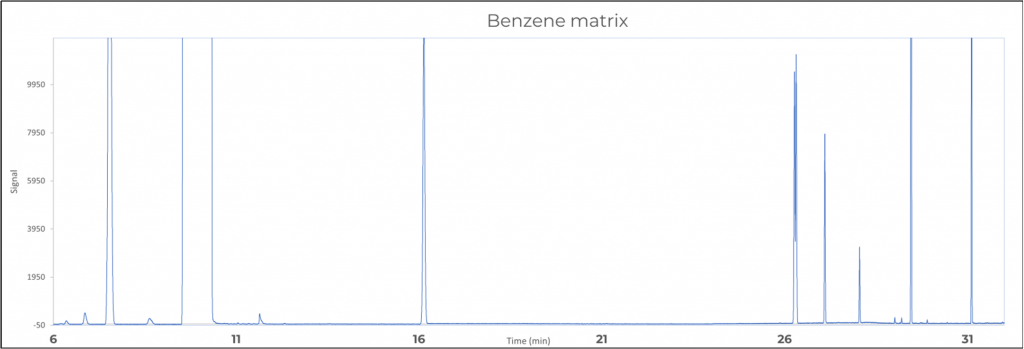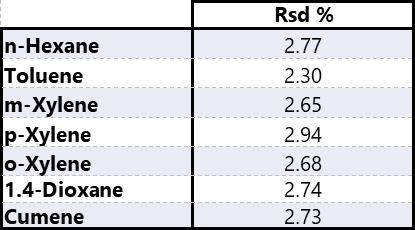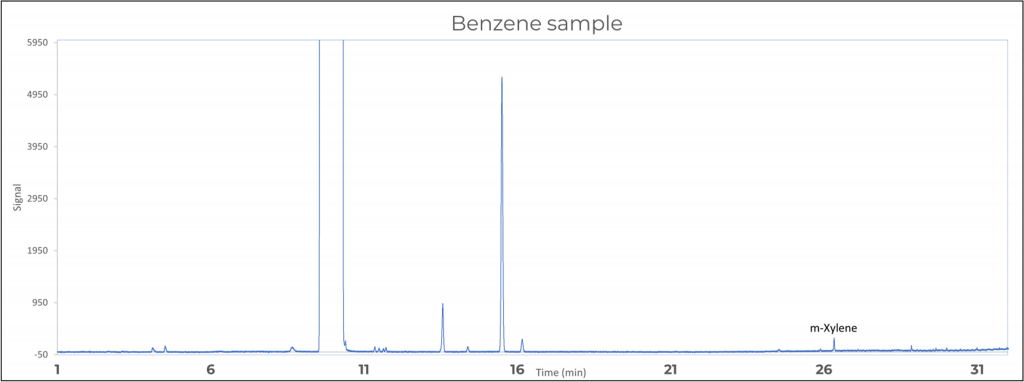UOP555, Trace impurities in Benzene by Gas Chromatography
Introduction
SCION Instruments offers the solution for trace impurities in high-purity benzene by gas chromatography (GC).
After manufacturing products might contain trace impurities. The UOP555 describes the determination of individual and total trace hydrocarbon impurities in olefin-free, high purity benzene. It is possible to determine C8, lower boiling paraffines, naphthenes, toluene and C8 aromatics.
This application is applicable on the SCION Instruments 4X6 and the new 8X00 GC-platform. Figure 1 shows the new SCION Instruments 8X00 GC platform with 8400PRO autosampler.
Figure 1. SCION Instruments 8300 and 8500 GC platform equipped with the 8400PRO autosampler.
Results and Discussion
UOP555 describes the determination of individual and total trace hydrocarbon impurities in olefin-free, high purity benzene. It is possible to determine C8, lower boiling paraffines, naphthene, toluene and C8 aromatics.
Table 1. Analytical conditions.
After manufacturing the product might contain trace impurities, this analysis can determine the type and amount of these hydrocarbon impurities. The lower limit of quantitation (LOQ) for any single component is 1 mg/kg.
When looking at interreferences it shows that the complete separation of m-xylene and p-xylene can be problematic when these components are analysed. The separation can be considered adequate when the distance to from the baseline to the valley between two peaks is not greater than 50% of the peak height, this is determined by the lowest of the two peaks.
It is important to check the separation of these components with a check sample before implementing the method. Figure 2 shows an example chromatogram of standard ST00033, and figure 3 shows the m/p-xylene separation of this standard. In addition, the check sample can be used to determine the retentions times of the components.
Figure 2. Example chromatogram of standard ST000033.
Figure 3. Separation example of m-xylene and p-xylene using standard ST000033.
This method uses the effective carbon number (ECN) since the FID does not response equally on a mass basis to all the components. In addition to this theoretical factor the absolute response factor for n-octane is calculated using the calibration blend.
Using both the ECN and calculated response factor the mass of the components can be calculated in mg/kg.
The repeatability of the method was determined by performing seven consecutive injections of standard ST000033. This mixture is a certified standard with low concentrations. The results in table 2 show good results for these low concentrations.
Table 2. Repeatability of ST00033.
Table 3. Benzene sample results in mg/kg.
Figure 4 shows an example chromatogram from a actual benzene sample. In this chromatogram 0.80 mg/kg Toluene and 0.26 mg/kg m-Xylene was identified and determined (table 3). In addition, there is also 25.2 mg/kg unknow impurities present in the sample.
Figure 4. Example chromatogram of a Benzene sample.
Conclusion
The SCION 8X00-GC analyser is perfectly capable of individual and total trace hydrocarbon impurities in olefin-free, high purity benzene with good repeatability and in compliance with UOP555.
The equipment of the 8X00-GC analyser is pre determined. Ordering information can be found on the next page. For customisation please contact your local sales representative.
Although the 4X6-GC series is not shown in this application note, it is possible to perform this analysis on the SCION Instruments 4X6 GC series.
Order Information
Download Application Note
Download complete Application Note here: UOP555, Trace impurities in Benzene by Gas chromatography.
Keep in Touch
If you wish to keep up to date with SCION Instruments latest research and articles, why not join us on social media and sign up to our LinkedIn newsletters today?









